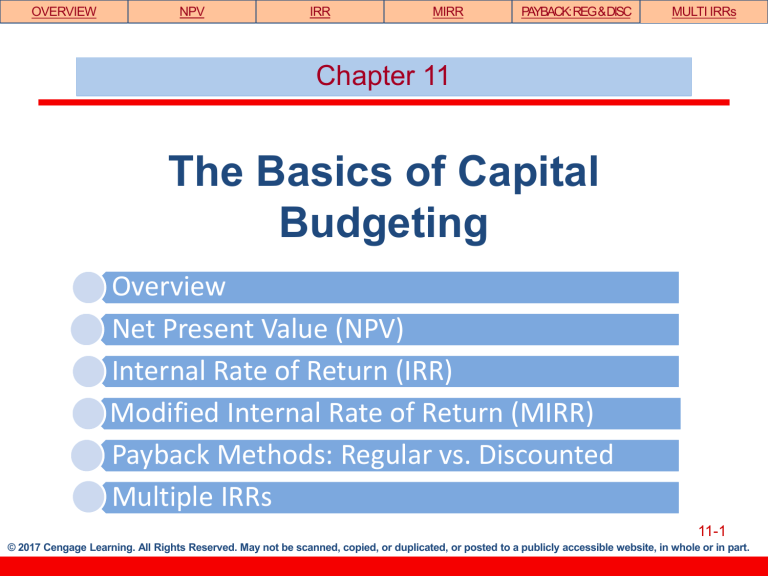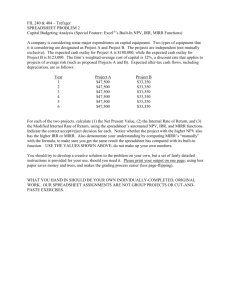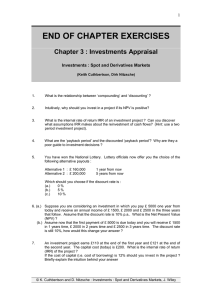
OVERVIEW
NPV
IRR
MIRR
PAYBACK: REG &DISC
MULTI IRRs
Chapter 11
The Basics of Capital
Budgeting
Overview
Net Present Value (NPV)
Internal Rate of Return (IRR)
Modified Internal Rate of Return (MIRR)
Payback Methods: Regular vs. Discounted
Multiple IRRs
11-1
© 2017 Cengage Learning. All Rights Reserved. May not be scanned, copied, or duplicated, or posted to a publicly accessible website, in whole or in part.
OVERVIEW
NPV
IRR
MIRR
PAYBACK: REG &DISC
MULTI IRRs
What is capital budgeting?
•
•
•
Analysis of potential additions to fixed assets.
Long-term decisions; involve large
expenditures.
Very important to firm’s future.
11-2
© 2017 Cengage Learning. All Rights Reserved. May not be scanned, copied, or duplicated, or posted to a publicly accessible website, in whole or in part.
OVERVIEW
NPV
IRR
MIRR
PAYBACK: REG &DISC
MULTI IRRs
Steps to Capital Budgeting
1.
Estimate CFs (inflows & outflows).
2.
Assess riskiness of CFs.
3.
Determine the appropriate cost of capital.
4.
Find NPV and/or IRR.
5.
Accept if NPV > 0 and/or IRR > WACC.
11-3
© 2017 Cengage Learning. All Rights Reserved. May not be scanned, copied, or duplicated, or posted to a publicly accessible website, in whole or in part.
OVERVIEW
NPV
IRR
MIRR
PAYBACK: REG &DISC
MULTI IRRs
What is the difference between independent and
mutually exclusive projects?
•
•
Independent projects: If the cash flows of one
are unaffected by the acceptance of the other.
Mutually exclusive projects: If the cash flows of
one can be adversely impacted by the
acceptance of the other.
11-4
© 2017 Cengage Learning. All Rights Reserved. May not be scanned, copied, or duplicated, or posted to a publicly accessible website, in whole or in part.
Net Present Value
•
•
The difference between the market value of a
project and its cost
How much value is created from undertaking an
investment?
The first step is to estimate the expected future cash
flows.
The second step is to estimate the required return for
projects of this risk level.
The third step is to find the present value of the cash
flows and subtract the initial investment.
NPV – DECISION RULE
•
•
•
If the NPV is positive, accept the project
A positive NPV means that the project is
expected to add value to the firm and will
therefore increase the wealth of the owners.
Since our goal is to increase owner wealth,
NPV is a direct measure of how well this project
will meet our goal.
OVERVIEW
NPV
IRR
MIRR
PAYBACK: REG &DISC
MULTI IRRs
Net Present Value (NPV)
•
Sum of the PVs of all cash inflows and outflows
of a project:
N
CFt
NPV
t
(
1
r
)
t0
11-7
© 2017 Cengage Learning. All Rights Reserved. May not be scanned, copied, or duplicated, or posted to a publicly accessible website, in whole or in part.
OVERVIEW
NPV
IRR
MIRR
PAYBACK: REG &DISC
MULTI IRRs
Example
Projects we’ll examine:
Year
0
1
2
3
Cash Flow
L
S
-100
-100
10
70
60
50
80
20
CF
0
-60
10
60
CF is the difference between CFL and CFS. We’ll
use CF later.
11-8
© 2017 Cengage Learning. All Rights Reserved. May not be scanned, copied, or duplicated, or posted to a publicly accessible website, in whole or in part.
OVERVIEW
NPV
IRR
MIRR
PAYBACK: REG &DISC
MULTI IRRs
What is Project L’s NPV?
WACC = 10%
Year
0
1
2
3
CFt
-100
10
60
80
PV of CFt
-$100.00
9.09
49.59
60.11
NPVL = $ 18.79
Excel: =NPV(rate,CF1:CFn) + CF0
Here, CF0 is negative.
11-9
© 2017 Cengage Learning. All Rights Reserved. May not be scanned, copied, or duplicated, or posted to a publicly accessible website, in whole or in part.
OVERVIEW
NPV
IRR
MIRR
PAYBACK: REG &DISC
MULTI IRRs
What is Project S’ NPV?
WACC = 10%
Year
0
1
2
3
CFt
-100
70
50
20
PV of CFt
-$100.00
63.64
41.32
15.02
NPVS = $ 19.98
Excel: =NPV(rate,CF1:CFn) + CF0
Here, CF0 is negative.
11-10
© 2017 Cengage Learning. All Rights Reserved. May not be scanned, copied, or duplicated, or posted to a publicly accessible website, in whole or in part.
OVERVIEW
NPV
IRR
MIRR
PAYBACK: REG &DISC
MULTI IRRs
Solving for NPV:
Financial Calculator Solution
Enter CFs into the calculator’s CFLO register.
CF0 = -100
CF1 = 10
CF2 = 60
CF3 = 80
Enter I/YR = 10, press NPV button to get
NPVL = $18.78.
11-11
© 2017 Cengage Learning. All Rights Reserved. May not be scanned, copied, or duplicated, or posted to a publicly accessible website, in whole or in part.
OVERVIEW
NPV
IRR
MIRR
PAYBACK: REG &DISC
MULTI IRRs
Rationale for the NPV Method
•
•
•
NPV = PV of inflows – Cost
= Net gain in wealth
If projects are independent, accept if the
project NPV > 0.
If projects are mutually exclusive, accept
project with the highest positive NPV, one that
adds the most value.
In this example, accept S if mutually exclusive
(NPVS > NPVL), and accept both if
independent.
11-12
© 2017 Cengage Learning. All Rights Reserved. May not be scanned, copied, or duplicated, or posted to a publicly accessible website, in whole or in part.
Internal Rate of Return
•
•
•
This is the most important alternative to NPV
It is often used in practice and is intuitively
appealing
It is based entirely on the estimated cash flows and
is independent of interest rates found elsewhere
IRR – DEFINITION AND DECISION RULE
•
•
Definition: IRR is the return that makes the
NPV = 0
Decision Rule: Accept the project if the
IRR is greater than the WACC
OVERVIEW
NPV
IRR
MIRR
PAYBACK: REG &DISC
MULTI IRRs
Internal Rate of Return (IRR)
•
IRR is the discount rate that forces PV of
inflows equal to cost, and the NPV = 0:
N
CFt
t
t 0 (1 IRR)
0
•
Solving for IRR with a financial calculator:
–
–
Enter CFs in CFLO register.
Press IRR; IRRL = 18.13% and
IRRS = 23.56%.
11-15
© 2017 Cengage Learning. All Rights Reserved. May not be scanned, copied, or duplicated, or posted to a publicly accessible website, in whole or in part.
OVERVIEW
NPV
IRR
MIRR
PAYBACK: REG &DISC
MULTI IRRs
How is a project’s IRR similar to a bond’s YTM?
•
•
•
They are the same thing.
Think of a bond as a project. The YTM on the
bond would be the IRR of the “bond” project.
EXAMPLE: Suppose a 10-year bond with a 9%
annual coupon and $1,000 par value sells for
$1,134.20.
– Solve for IRR = YTM = 7.08%, the annual return
for this project/bond.
11-16
© 2017 Cengage Learning. All Rights Reserved. May not be scanned, copied, or duplicated, or posted to a publicly accessible website, in whole or in part.
OVERVIEW
NPV
IRR
MIRR
PAYBACK: REG &DISC
MULTI IRRs
Rationale for the IRR Method
•
If IRR > WACC, the project’s return exceeds its
costs and there is some return left over to
boost stockholders’ returns.
If IRR > WACC, accept project.
•
•
If IRR < WACC, reject project.
If projects are independent, accept both
projects, as both IRR > WACC = 10%.
If projects are mutually exclusive, accept S,
because IRRs > IRRL.
11-17
© 2017 Cengage Learning. All Rights Reserved. May not be scanned, copied, or duplicated, or posted to a publicly accessible website, in whole or in part.
OVERVIEW
NPV
IRR
MIRR
PAYBACK: REG &DISC
MULTI IRRs
NPV Profiles
•
A graphical representation of project NPVs at
various different costs of capital.
WACC
0
5
10
15
20
NPVL
$50
33
19
7
(4)
NPVS
$40
29
20
12
5
11-18
© 2017 Cengage Learning. All Rights Reserved. May not be scanned, copied, or duplicated, or posted to a publicly accessible website, in whole or in part.
OVERVIEW
NPV
IRR
MIRR
PAYBACK: REG &DISC
MULTI IRRs
Independent Projects
NPV and IRR always lead to the same
accept/reject decision for any given independent
project.
NPV ($)
IRR > r
and NPV > 0
Accept.
r > IRR
and NPV < 0.
Reject.
r = 18.1%
IRRL = 18.1%
r (%)
11-19
© 2017 Cengage Learning. All Rights Reserved. May not be scanned, copied, or duplicated, or posted to a publicly accessible website, in whole or in part.
OVERVIEW
NPV
IRR
MIRR
PAYBACK: REG &DISC
MULTI IRRs
Mutually Exclusive Projects
If r < 8.7%: NPVL > NPVS
IRRS > IRRL
CONFLICT
NPV
L
If r > 8.7%: NPVS > NPVL ,
IRRS > IRRL
NO CONFLICT
S
r
8.7
%
r
IRRL
IRRs
11-20
© 2017 Cengage Learning. All Rights Reserved. May not be scanned, copied, or duplicated, or posted to a publicly accessible website, in whole or in part.
OVERVIEW
NPV
IRR
MIRR
PAYBACK: REG &DISC
MULTI IRRs
What is the difference between normal and
nonnormal cash flow streams?
•
•
Normal cash flow stream: Cost (negative CF)
followed by a series of positive cash inflows.
One change of signs.
Nonnormal cash flow stream: Two or more
changes of signs. Most common: Cost
(negative CF), then string of positive CFs, then
cost to close project. Examples include nuclear
power plant, strip mine, etc.
11-21
© 2017 Cengage Learning. All Rights Reserved. May not be scanned, copied, or duplicated, or posted to a publicly accessible website, in whole or in part.
OVERVIEW
NPV
IRR
MIRR
PAYBACK: REG &DISC
MULTI IRRs
Find Project P’s NPV and IRR
Project P has cash flows (in 000s): CF0 = -$800,
CF1 = $5,000, and CF2 = -$5,000.
0
-800
•
•
•
•
1
2
5,000
-5,000
WACC = 10%
Enter CFs into calculator CFLO register.
Enter I/YR = 10.
NPV = -$386.78.
IRR = 25% AND 400% ??
11-22
© 2017 Cengage Learning. All Rights Reserved. May not be scanned, copied, or duplicated, or posted to a publicly accessible website, in whole or in part.
OVERVIEW
NPV
IRR
MIRR
PAYBACK: REG &DISC
MULTI IRRs
Multiple IRRs
NPV
IRR2 = 400%
450
0
-800
100
400
WACC
IRR1 = 25%
11-23
© 2017 Cengage Learning. All Rights Reserved. May not be scanned, copied, or duplicated, or posted to a publicly accessible website, in whole or in part.
OVERVIEW
NPV
IRR
MIRR
PAYBACK: REG &DISC
MULTI IRRs
If managers prefer the IRR to the NPV method; is
there a better IRR measure?
•
•
Yes, MIRR is the discount rate that causes the
PV of a project’s terminal value (TV) to equal
the PV of costs. TV is found by compounding
inflows at WACC.
MIRR assumes cash flows are reinvested at
the WACC.
11-24
© 2017 Cengage Learning. All Rights Reserved. May not be scanned, copied, or duplicated, or posted to a publicly accessible website, in whole or in part.
OVERVIEW
NPV
IRR
MIRR
PAYBACK: REG &DISC
MULTI IRRs
Why use MIRR versus IRR?
•
•
•
MIRR assumes reinvestment at the opportunity
cost = WACC.
Managers like rate of return comparisons, and
MIRR is better for this than IRR.
MIRR solves for IRR unreliable results with
non conventional cash flows and mutually
exclusive projects.
11-25
© 2017 Cengage Learning. All Rights Reserved. May not be scanned, copied, or duplicated, or posted to a publicly accessible website, in whole or in part.
OVERVIEW
NPV
IRR
MIRR
PAYBACK: REG &DISC
MULTI IRRs
Calculating MIRR
0
10%
-100.0
1
2
3
10.0
60.0
80.0
10%
10%
MIRR = 16.5%
-100.0
PV outflows
$158.1
$100 =
(1 + MIRRL)3
MIRRL = 16.5%
66.0
12.1
158.1
TV inflows
PV ($100); N 3; FV $158.1; PMT $0
CPT I/Y = 16.5%
11-26
© 2017 Cengage Learning. All Rights Reserved. May not be scanned, copied, or duplicated, or posted to a publicly accessible website, in whole or in part.
OVERVIEW
NPV
IRR
MIRR
PAYBACK: REG &DISC
MULTI IRRs
What is the payback period?
•
•
The number of years required to recover a
project’s cost, or “How long does it take to get
our money back?”
Calculated by adding project’s cash inflows to
its cost until the cumulative cash flow for the
project turns positive.
11-27
© 2017 Cengage Learning. All Rights Reserved. May not be scanned, copied, or duplicated, or posted to a publicly accessible website, in whole or in part.
OVERVIEW
NPV
IRR
MIRR
PAYBACK: REG &DISC
MULTI IRRs
Calculating Payback
Project L’s Payback Calculation
0
1
2
3
CFt
-100
10
60
80
Cumulative
-100
-90
-30
50
PaybackL = 2 + 30 / 80
= 2.375 years
PaybackS = 1.600 years
11-28
© 2017 Cengage Learning. All Rights Reserved. May not be scanned, copied, or duplicated, or posted to a publicly accessible website, in whole or in part.
OVERVIEW
NPV
IRR
MIRR
PAYBACK: REG &DISC
MULTI IRRs
Discounted Payback Period
Uses discounted cash flows rather than raw CFs.
0
10%
1
2
3
10
60
80
CFt
-100
PV of CFt
-100
9.09
49.59
60.11
Cumulative
-100
-90.91
-41.32
18.79
Disc PaybackL = 2 + 41.32 / 60.11
= 2.7 years
11-29
© 2017 Cengage Learning. All Rights Reserved. May not be scanned, copied, or duplicated, or posted to a publicly accessible website, in whole or in part.
OVERVIEW
NPV
IRR
MIRR
PAYBACK: REG &DISC
MULTI IRRs
Strengths and Weaknesses of Payback
•
•
Strengths
– Provides an indication of a project’s risk and
–
liquidity.
Easy to calculate and understand.
Weaknesses
– Ignores the time value of money (TVM).
– Ignores CFs occurring after the payback period.
– No relationship between a given payback and
investor wealth maximization.
Discounted payback considers TVM, but other 2
flaws remain.
11-30
© 2017 Cengage Learning. All Rights Reserved. May not be scanned, copied, or duplicated, or posted to a publicly accessible website, in whole or in part.






